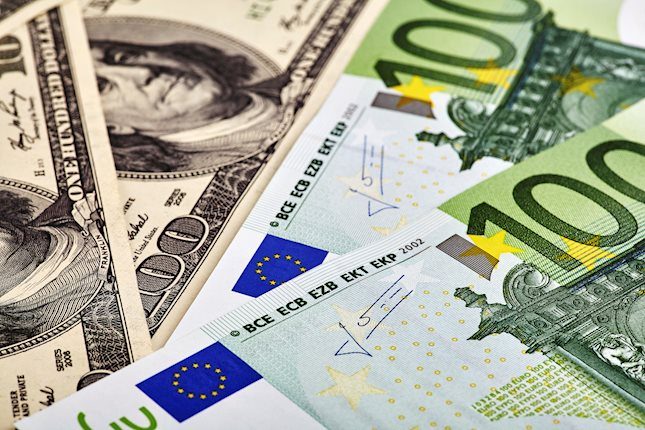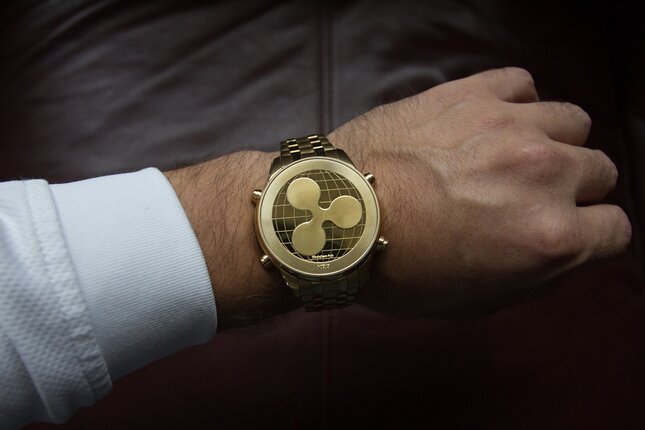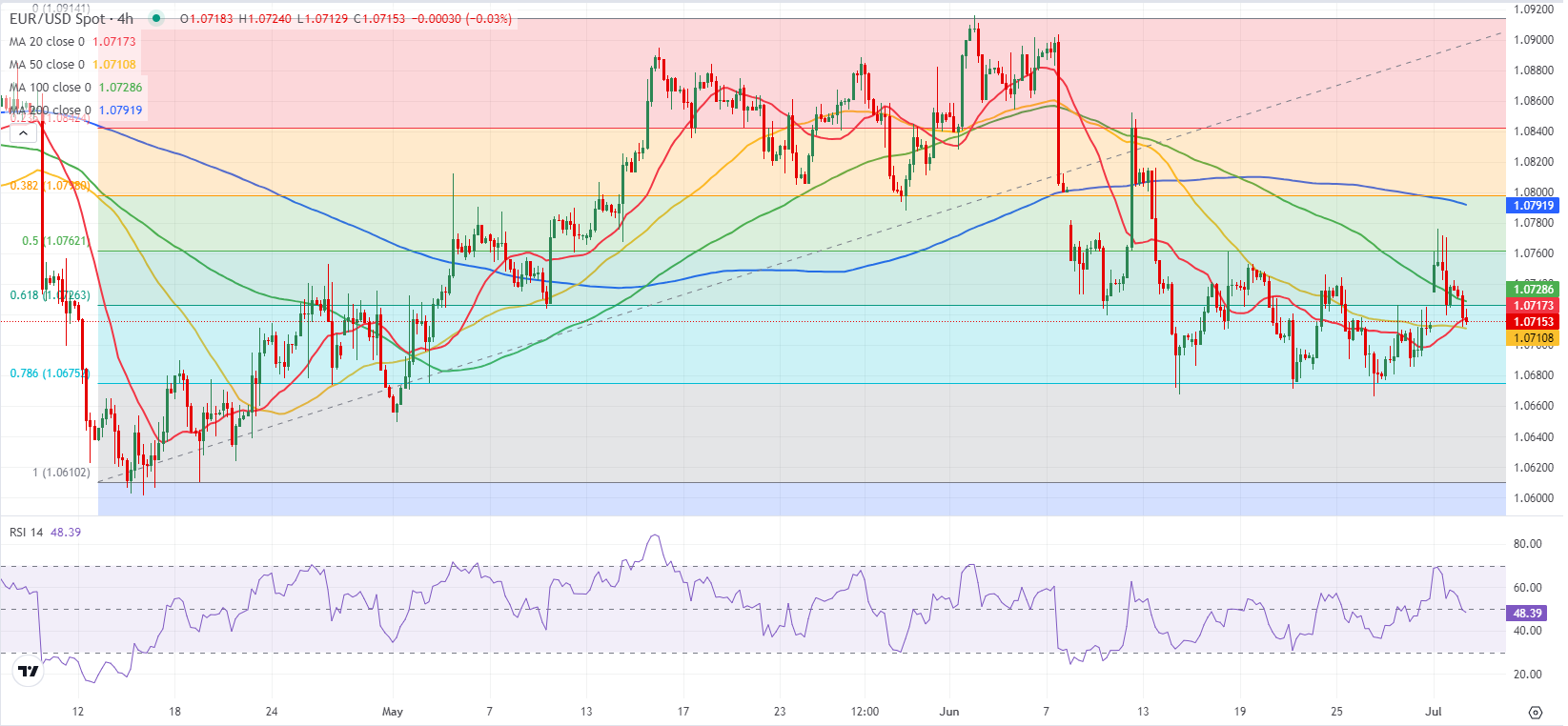- EUR/USD declines toward 1.0700 in the European session on Thursday.
- The technical outlook points to a loss of bullish momentum.
- ECB President Lagarde and Fed Chairman Powell will speak on policy later in the day.
Following a bullish opening to the week, EUR/USD climbed to its highest level in over two weeks above 1.0770 on Monday. The pair, however, lost its momentum and declined below 1.0750.
Euro PRICE Today
The table below shows the percentage change of Euro (EUR) against listed major currencies today. Euro was the weakest against the Canadian Dollar.
| USD | EUR | GBP | JPY | CAD | AUD | NZD | CHF | |
|---|---|---|---|---|---|---|---|---|
| USD | 0.25% | 0.16% | 0.10% | -0.02% | 0.18% | 0.37% | 0.18% | |
| EUR | -0.25% | -0.09% | -0.14% | -0.26% | -0.07% | 0.10% | -0.06% | |
| GBP | -0.16% | 0.09% | -0.04% | -0.16% | 0.00% | 0.20% | 0.01% | |
| JPY | -0.10% | 0.14% | 0.04% | -0.13% | 0.09% | 0.25% | 0.07% | |
| CAD | 0.02% | 0.26% | 0.16% | 0.13% | 0.20% | 0.39% | 0.20% | |
| AUD | -0.18% | 0.07% | 0.00% | -0.09% | -0.20% | 0.18% | -0.01% | |
| NZD | -0.37% | -0.10% | -0.20% | -0.25% | -0.39% | -0.18% | -0.19% | |
| CHF | -0.18% | 0.06% | -0.01% | -0.07% | -0.20% | 0.00% | 0.19% |
The heat map shows percentage changes of major currencies against each other. The base currency is picked from the left column, while the quote currency is picked from the top row. For example, if you pick the Euro from the left column and move along the horizontal line to the US Dollar, the percentage change displayed in the box will represent EUR (base)/USD (quote).
The Euro gathered strength to start the week as markets reacted to the outcome of the first round of France's parliamentary election, as Marine Le Pen's far-right National Rally (RN) party won by a smaller gap than initially projected. The positive impact of this development on the Euro's valuation faded away later in the day, causing EUR/USD to erase its daily gains.
On Tuesday, the data published by Eurostat showed that the Harmonized Index of Consumer Prices, the European Central Bank's (ECB) preferred gauge of inflation, rose 2.5% on a yearly basis in June, down from 2.6% in May. This reading came in line with the market expectation. In the same period, the core HICP, which excludes volatile food and energy prices, rose 2.9% to match May's increase. These figures failed to trigger a noticeable market reaction.
Later in the day, ECB President Christine Lagarde and Federal Reserve (Fed) Chairman Jerome Powell will speak on policy outlook at the ECB Forum on Central Banking.
In case this event highlights the diverging monetary policies between the Fed and the ECB, EUR/USD could extend its slide in the American session. On the other hand, investors could continue to price in a September Fed rate cut and cause the USD could come under bearish pressure if Powell acknowledges improvements in inflation.
EUR/USD Technical Analysis
The Relative Strength Index (RSI) indicator on the 4-hour chart retreated below 50 in the European session on Tuesday, reflecting the loss of bullish momentum. On the downside, 1.0700 (static level, psychological level) aligns as immediate support before 1.0670 (Fibonacci 78.6% retracement of the latest uptrend) and 1.0600 (static level).
The 100-period Simple Moving Average (SMA) of the 4-hour chart could be seen as interim resistance at 1.0730 before 1.0780-1.0790 (100-day SMA, 200-day SMA).
Central banks FAQs
Central Banks have a key mandate which is making sure that there is price stability in a country or region. Economies are constantly facing inflation or deflation when prices for certain goods and services are fluctuating. Constant rising prices for the same goods means inflation, constant lowered prices for the same goods means deflation. It is the task of the central bank to keep the demand in line by tweaking its policy rate. For the biggest central banks like the US Federal Reserve (Fed), the European Central Bank (ECB) or the Bank of England (BoE), the mandate is to keep inflation close to 2%.
A central bank has one important tool at its disposal to get inflation higher or lower, and that is by tweaking its benchmark policy rate, commonly known as interest rate. On pre-communicated moments, the central bank will issue a statement with its policy rate and provide additional reasoning on why it is either remaining or changing (cutting or hiking) it. Local banks will adjust their savings and lending rates accordingly, which in turn will make it either harder or easier for people to earn on their savings or for companies to take out loans and make investments in their businesses. When the central bank hikes interest rates substantially, this is called monetary tightening. When it is cutting its benchmark rate, it is called monetary easing.
A central bank is often politically independent. Members of the central bank policy board are passing through a series of panels and hearings before being appointed to a policy board seat. Each member in that board often has a certain conviction on how the central bank should control inflation and the subsequent monetary policy. Members that want a very loose monetary policy, with low rates and cheap lending, to boost the economy substantially while being content to see inflation slightly above 2%, are called ‘doves’. Members that rather want to see higher rates to reward savings and want to keep a lit on inflation at all time are called ‘hawks’ and will not rest until inflation is at or just below 2%.
Normally, there is a chairman or president who leads each meeting, needs to create a consensus between the hawks or doves and has his or her final say when it would come down to a vote split to avoid a 50-50 tie on whether the current policy should be adjusted. The chairman will deliver speeches which often can be followed live, where the current monetary stance and outlook is being communicated. A central bank will try to push forward its monetary policy without triggering violent swings in rates, equities, or its currency. All members of the central bank will channel their stance toward the markets in advance of a policy meeting event. A few days before a policy meeting takes place until the new policy has been communicated, members are forbidden to talk publicly. This is called the blackout period.
Information on these pages contains forward-looking statements that involve risks and uncertainties. Markets and instruments profiled on this page are for informational purposes only and should not in any way come across as a recommendation to buy or sell in these assets. You should do your own thorough research before making any investment decisions. FXStreet does not in any way guarantee that this information is free from mistakes, errors, or material misstatements. It also does not guarantee that this information is of a timely nature. Investing in Open Markets involves a great deal of risk, including the loss of all or a portion of your investment, as well as emotional distress. All risks, losses and costs associated with investing, including total loss of principal, are your responsibility. The views and opinions expressed in this article are those of the authors and do not necessarily reflect the official policy or position of FXStreet nor its advertisers. The author will not be held responsible for information that is found at the end of links posted on this page.
If not otherwise explicitly mentioned in the body of the article, at the time of writing, the author has no position in any stock mentioned in this article and no business relationship with any company mentioned. The author has not received compensation for writing this article, other than from FXStreet.
FXStreet and the author do not provide personalized recommendations. The author makes no representations as to the accuracy, completeness, or suitability of this information. FXStreet and the author will not be liable for any errors, omissions or any losses, injuries or damages arising from this information and its display or use. Errors and omissions excepted.
The author and FXStreet are not registered investment advisors and nothing in this article is intended to be investment advice.
Recommended Content
Editors’ Picks

EUR/USD sits at yearly lows near 1.0550 ahead of EU GDP, US PPI data
EUR/USD is trading near 1.0550 in the European session on Thursday, sitting at the lowest level in a year. The Trump trades-driven relentless US Dollar buying and German political instability weigh on the pair. Traders await EU GDP data and US PPI report ahead of Fed Chair Powell's speech.

GBP/USD holds losses below 1.2700 on sustained US Dollar strength
GBP/USD is holding losses near multi-month lows below 1.2700 in European trading on Thursday. The pair remains vulnerable amid a broadly firmer US Dollar and softer risk tone even as BoE policymakers stick to a cautious stance on policy. Speeches from Powell and Bailey are eyed.

Gold price hits fresh two-month low as the post-election USD rally remains uninterrupted
Gold price drifts lower for the fifth consecutive day and drops to its lowest level since September 19, around the $2,554-2,553 region heading into the European session on Thursday. The commodity continues to be weighed down by an extension of the US Dollar's post-election rally to a fresh year-to-date.

XRP struggles near $0.7440, could still sustain rally after Robinhood listing
Ripple's XRP is trading near $0.6900, down nearly 3% on Wednesday, as declining open interest could extend its price correction. However, other on-chain metrics point to a long-term bullish setup.

Trump vs CPI
US CPI for October was exactly in line with expectations. The headline rate of CPI rose to 2.6% YoY from 2.4% YoY in September. The core rate remained steady at 3.3%. The detail of the report shows that the shelter index rose by 0.4% on the month, which accounted for 50% of the increase in all items on a monthly basis.

Best Forex Brokers with Low Spreads
VERIFIED Low spreads are crucial for reducing trading costs. Explore top Forex brokers offering competitive spreads and high leverage. Compare options for EUR/USD, GBP/USD, USD/JPY, and Gold.
